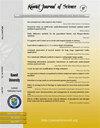聚苯乙烯-金海胆表面功能化测定脑损伤生物标志物
IF 1.1
4区 综合性期刊
Q3 MULTIDISCIPLINARY SCIENCES
引用次数: 0
摘要
研究人员正致力于开发材料辅助生物传感策略和利用基于血液的生物标志物进行创伤性脑损伤(TBI)诊断。本研究旨在建立一种利用金海胆介导的酶联免疫吸附试验(ELISA)检测TBI生物标志物S100β的高灵敏度方法。在这种方法中,抗s100 β多克隆抗体通过金海胆附着在聚苯乙烯底物上。S100β夹在多克隆抗体和单克隆抗体之间,在0.001 ~ 1000 ng/mL的线性曲线上,检测限为1 pg/mL, R2值为0.9419 [y = 0.095x ~ 0.0206]。与不含金海胆的常规ELISA相比,该方法具有更好的检测效果[y = 0.0857x - 0.0763, R2 = 0.9736]。此外,γ-氨基丁酸和胶质纤维酸性蛋白的对照实验没有增加光密度,证实了S100β的特异性检测。这种S100β生物传感器带来了一种新奇的东西,它使用独特的纳米材料来增强聚苯乙烯的表面积,并有效地检测低水平的S100β,帮助诊断脑损伤。本文章由计算机程序翻译,如有差异,请以英文原文为准。
Surface functionalized on polystyrene-gold urchin for determining brain injury biomarker
Researchers are focusing on developing materials-aided biosensing strategies and utilizing blood-based biomarkers for traumatic brain injury (TBI) diagnosis. This study aims to develop a highly sensitive method for detecting the TBI biomarker S100β using a gold urchin-mediated ELISA. In this approach, anti-S100β polyclonal antibodies were attached to a polystyrene substrate via gold urchins. S100β was sandwiched between polyclonal and monoclonal antibodies, achieving a limit of detection of 1 pg/mL with an R2 value of 0.9419 [y = 0.095x - 0.0206] on the linear curve within the range of 0.001–1000 ng/mL. This method displayed better performance compared to conventional ELISA without gold urchins, which had [y = 0.0857x - 0.0763, R2 = 0.9736]. Furthermore, control experiments with γ-aminobutyric acid and glial fibrillary acidic proteins did not increase optical density, confirming the specific detection of S100β. This S100β biosensor has brought a novelty with a unique nanomaterial to enhance the polystyrene surface area and effectively detects low levels of S100β, aiding the diagnosis of brain injury.
求助全文
通过发布文献求助,成功后即可免费获取论文全文。
去求助
来源期刊

Kuwait Journal of Science
MULTIDISCIPLINARY SCIENCES-
CiteScore
1.60
自引率
28.60%
发文量
132
期刊介绍:
Kuwait Journal of Science (KJS) is indexed and abstracted by major publishing houses such as Chemical Abstract, Science Citation Index, Current contents, Mathematics Abstract, Micribiological Abstracts etc. KJS publishes peer-review articles in various fields of Science including Mathematics, Computer Science, Physics, Statistics, Biology, Chemistry and Earth & Environmental Sciences. In addition, it also aims to bring the results of scientific research carried out under a variety of intellectual traditions and organizations to the attention of specialized scholarly readership. As such, the publisher expects the submission of original manuscripts which contain analysis and solutions about important theoretical, empirical and normative issues.
 求助内容:
求助内容: 应助结果提醒方式:
应助结果提醒方式:


